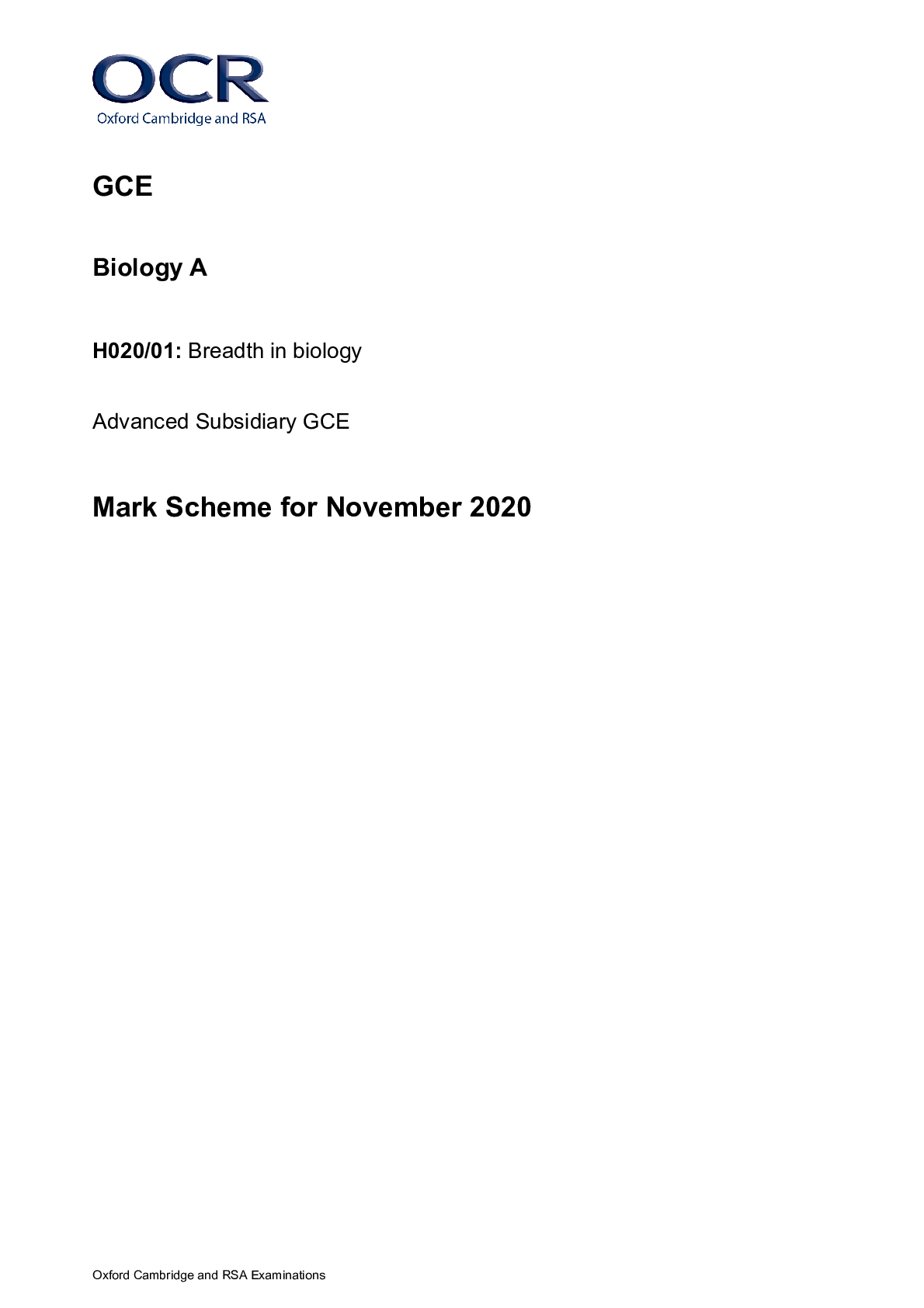Classical Civilisation > GCSE MARK SCHEME > GCSE (9–1) Classical Civilisation J199/11: Myth and religion General Certificate of Secondary Educ (All)
GCSE (9–1) Classical Civilisation J199/11: Myth and religion General Certificate of Secondary Education Mark Scheme for November 2020
Document Content and Description Below
GCSE (9–1) Classical Civilisation J199/11: Myth and religion General Certificate of Secondary Education Mark Scheme for November 2020 Oxford Cambridge and RSA Examinations GCSE (9–1) Classical ... Civilisation J199/11: Myth and religion General Certificate of Secondary Education Mark Scheme for November 2020Oxford Cambridge and RSA Examinations OCR (Oxford Cambridge and RSA) is a leading UK awarding body, providing a wide range of qualifications to meet the needs of candidates of all ages and abilities. OCR qualifications include AS/A Levels, Diplomas, GCSEs, Cambridge Nationals, Cambridge Technicals, Functional Skills, Key Skills, Entry Level qualifications, NVQs and vocational qualifications in areas such as IT, business, languages, teaching/training, administration and secretarial skills. It is also responsible for developing new specifications to meet national requirements and the needs of students and teachers. OCR is a not-for-profit organisation; any surplus made is invested back into the establishment to help towards the development of qualifications and support, which keep pace with the changing needs of today’s society. This mark scheme is published as an aid to teachers and students, to indicate the requirements of the examination. It shows the basis on which marks were awarded by examiners. It does not indicate the details of the discussions which took place at an examiners’ meeting before marking commenced. All examiners are instructed that alternative correct answers and unexpected approaches in candidates’ scripts must be given marks that fairly reflect the relevant knowledge and skills demonstrated. Mark schemes should be read in conjunction with the published question papers and the report on the examination. © OCR 2020J199/11 Mark Scheme November 2020 2 Annotations Annotation Meaning Blank Page Unclear Incorrect Questionable response Tick Omission mark Seen Highlight Benefit of doubt RepetitionJ199/11 Mark Scheme November 2020 3 Spelling Too vagueJ199/11 Mark Scheme November 2020 4 Question Indicative Content Marks (AO) Guidance Section A 1a State two reasons why the figure in the centre of Source A has been identified as Dionysos. Two from: He is holding a (wine) cup (1) he is accompanied by satyrs and/or maenads (1) he is wearing a crown/wreath of ivy (1) he is surrounded by ivy (vines) (1). 2 (AO1) Insist on ‘ivy’ for both ‘crown/wreath’ and ‘vines’ 1b What might have Source A held which was connected to Dionysos? Wine (1) 1 (AO1) 2 What was the name of the festival held in Athens that worshipped Dionysos? (City) Dionysia (1) 1 (AO1) 3a State two events that took place during this festival. Two from: Pomp/ grand procession/arrival of Dionysos’ statue (1) komos (1) dithyramb contests (1) comedy (1) tragedy (1) satyr plays (1) sacrifice (1) 2 (AO1) b Why were these events suitable for the worship of Dionysos? The pompe/grand procession held a party-like atmosphere and Dionysos was the god of revelry/wine or sim. (1) In the pompe/komos phallus’ were carried and Dionysos was associated with fertility or sim. (1) Dionysos was the god of theatre or sim. (1) 1 (AO2) The answer to (b) must be in response to the answer given in (a). The answer must include acknowledgement of why Dionysos in particular was associated with that event.J199/11 Mark Scheme November 2020 5 4 Which of Heracles’ labours is shown in Source B? The apples of the Hesperides (1) retrieving the golden apples (1) 1 (AO1) If the candidates does not provide the labour name, allow any accurate description of the labour. 5 State two things Heracles did to complete this labour. Two from: Heracles fought a number of people in order to try and find the location of the apples (1) Heracles helped Prometheus who told him where the apples were (1) Heracles asked Atlas to retrieve the apples (1) while Heracles held up the sky (1) Heracles tricked Atlas into taking back the sky (1) Heracles ran back with the apples (1) or sim. 2 (AO1) REP: If incorrect answer given for Q4 accept correct description of the labour given a for Q5 6a State two reasons why Source B could be considered a well sculpted metope. Two from: The characters are well proportioned or sim. (1) The characters take up the whole of the metope with little space unused or sim. (1) the characters are sculpted with realism or sim. (1) The scene is easily recognisable due to Heracles’ pose/ Atlas holding the apples or sim. (1) 2 (AO1) 6b State one reason why metopes were a better way of displaying Heracles’ twelve labours compared to using a pediment. One from: The labours were twelve different events, a temple had lots of metopes so they could all be shown separately or sim. (1) Plus one from: a pediment was one (triangular) space so the stories would need to be put next to each other which could be confusing or sim. (1) 2 (AO1) Answer must specifically refer to Heracles’ labours rather than a generic explanation of the strengths and weaknesses of metopes/pediments 7 On which temple was Source C displayed? The Parthenon (1) 1 (AO1) 8a What caused the conflict shown in Source C? Give two details. 2 (AO1)J199/11 Mark Scheme November 2020 6 The centaurs drank too much wine (1) The centaurs abducted the Lapith women/ wife of the king or sim. (1) they fought with the Lapiths or sim. (1) 8b Why did the Greeks decide to include this story on some of their temples? It symbolised civilisation’s victory over barbarism (1) 1 (AO2) 9a What Greek religious practice does Source D explain the origins of? Sacrifices 1 (AO1) 9b What do you learn about this religious practice from Source D? State two details. The (thigh) bones covered in fat or sim. (1) was offered to the gods (1) 2 (AO1) What was given to the gods must be included for both marks. - ‘How the animal was divided for a sacrifice’ = 1 mark 9c Where would this religious practice have taken place in a Greek sanctuary? The altar 1 (AO1) 10 “The Great Panathenaia was more about competition rather than worshipping Athena.” How far do you agree with this statement? Use Source E and Source F as a starting point and your own knowledge in your answer. AO1 Candidates might show knowledge and understanding of: • Competitions - Sporting events: youth games, tribal games, equestrian events, apobates and boat racing (Source F) - Literary contests: Rhapsodic and musical competitions (Source F) - Panathenaic amphorae (Source F) 8 (see LoR) The ‘indicative content’ is a description of possible content only; all legitimate answers and approaches must be credited appropriately.J199/11 Mark Scheme November 2020 7 - Tribal contests • Religious Events - The Panathenaic procession (Source E & F) - The peplos (Source E) - Sacrifice - Torch race (could also be considered sporting) AO2 Candidates may demonstrate evaluation and analysis through the use of some of the following arguments: • In agreement with the statement - Far more of the events were competitive rather than religious - Variety of events could include everyone, sporting, literary, and individual and team (tribal) events. • Against the statement - The penultimate day was dedicated to Athena, all other events were leading up to the ‘main event’ - Panathenaic amphorae linked the competitions to Athena as she was painted on them and the prize was olive oil. - The procession, not sporting competitions, was part of the Parthenon’s decoration - The torch race was a mix of both, a race but to the altar of Athena and light the sacrificial fire.J199/11 Mark Scheme November 2020 8 Guidance on applying the marking grids for the 8-mark detailed response Two Assessment Objectives are being assessed in this question: AO1 (Demonstrate knowledge and understanding…) and AO2 (Analyse, interpret and evaluate…). The two Assessment Objectives are equally weighted, and both worth 4 marks. The weighting of assessment objectives remains consistent throughout the levels. Responses are credited for AO1 for the detail and accuracy of the knowledge of the sources, their context and interpretation. Responses are credited for AO2 for how well the question is addressed, selecting relevant evidence from the sources and the conclusions drawn. Examiners must use a best fit approach when applying the mark scheme. This means considering both the strengths and the weaknesses of a response, particularly if it is imbalanced in terms of the two assessment objectives, when deciding which level reflects the overall performance. AO1 and AO2 are closely interlinked. Typically responses demonstrate both knowledge and understanding and analysis and interpretation of that knowledge in reasonably equal measure. In this way, a total mark of 6 might reflect a balance of 3 (AO1) + 3 (AO2), for example. However, an overly-descriptive response may focus on details from the sources but not draw many valid conclusions; this would be considered AO1 heavy. Care should be taken when marking such answers, as the lack of AO2 skills should limit the level at which this work can be rewarded; it should not be possible to achieve a mark of 7 made up of 6 (AO1) + 1 (AO2). Examples of specific issues or common unbalanced approaches to the question will be identified when finalising the mark scheme in preparation for standardisation. Details about how to deal with this will be included in the Guidance column for the question. Level Mark Characteristics of Performance 4 7–8 • consistently accurate and detailed knowledge and understanding of classical sources, using both those given in assessment and own wider knowledge (AO1) shows very good understanding of the sources’ cultural contexts and possible interpretations • a well-argued response to the question which is supported by a range of well-selected evidence (AO2) includes critical analysis, interpretation and evaluation 3 5–6 • accurate knowledge and understanding of classical sources, using both those given in assessment and own wider knowledge (AO1) shows good understanding of the sources’ cultural contexts and/or possible interpretations • a focused response to the question which is supported by a range of evidence (AO2) includes relevant analysis, interpretation and evaluation 2 3–4 • sound, mostly accurate, knowledge and understanding of classical sources, using both those given in assessment and own wider knowledge (AO1) shows some understanding of the sources’ cultural contexts and/or possible interpretations • engages with the general topic of the question, and is supported by limited range of evidence (AO2) includes some analysis, interpretation and evaluation 1 1–2 • limited knowledge and understanding of classical sources; responses may only make use of the sources given in the assessment (AO1) shows limited understanding of the sources’ cultural contexts and/or possible interpretations • little attempt at a very basic explanation of the topic of the question, supported by a few references to evidence (AO2) includes isolated analysis, interpretation and evaluation 0 0 • No response or no response worthy of creditJ199/11 Mark Scheme November 2020 9 Question Section B Indicative Content Marks (AO) Guidance 11 What Roman festival is being described in Source G? The Saturnalia (1) 1 (AO1) 12a At what point of the year did this festival take place? Winter (solstice) /December (1) 1 (AO1) 12b State one reason why this time of year was appropriate for this festival. One from: It came at the end of the winter sowing (1) the time symbolised rebirth/new life or sim. (1) 1 (AO1) 13a State two other events that took place during this festival that are not mentioned in Source G. Public banquet/feast (1) (public) sacrifice (to Saturn) (1) family feast (1) 2 (AO1) 13b Why did this festival appeal to slaves? One from: Slaves were treated as equals for the day (1) roles in the household could be reversed for example masters serving slaves food (1) slaves could receive gifts from their master (1) 1 (AO2) 14 Who had Hercules fought immediately before the episode described in Source H? Achelous/a river god (1) 1 (AO1) 15 Where does the conversation in Source H take place? 1 (AO1)J199/11 Mark Scheme November 2020 10 By a river (Euenus)/ on the riverbank (1) 16a Why does Hercules describe Nessus as ‘twice-formed’ (line 2)? He is a centaur/ he is half man, half horse (1) 1 (AO1) 16b ‘Do not steal what is mine’ (line 2). Who has Nessus stolen? Deianira/ Hercules’ wife (1) 1 (AO1) Must be clear that it is Hercules’ wife and not Nessus’ 17ai What substance had Hercules added to the tip of the arrow used to shoot Nessus? Venom/poison (1) 1 (AO1) 17aii Where did this substance originally come from? The (Lernean) Hydra (1) 1 (AO1) 17b How did this substance later kill Hercules? It soaked a tunic that his wife later gave him as a present or sim (1) it melted his skin when he wore it or sim. (1) 1 (AO2) 18a What part of the burial process is shown in Source I? Prothesis/The preparation of the body (1) 1 (AO1) Allow identification of what is happening in Source I 18b Give one piece of evidence from source I to support your answer. The body is being clothed/covered (1) the body is being washed/ the last breath caught (1) mourners are present (1) 1 (AO1) Answer to (b) must relate to what has been written for part (a) 19a Where was the body placed immediately after the steps shown in source I were completed? The atrium/ main room (1) 1 (AO1)J199/11 Mark Scheme November 2020 11 19b How long was the body left here? 8 days (1) 1 (AO1) 19c Why was the body left here? To allow mourners to visit the deceased (1) to pay respects (1) to give offerings (1) or sim. 1 (AO1 20a What was the name of the festival that the Romans held in February to honour their dead family members? The Parentalia (1) 1 (AO1) 20b State one common offering given to the dead during this festival. One from: wreath/garland (1) meal (1) salt (1) wine-soaked bread (1) violets (1) 1 (AO1) 20c Where did the family gather to present this offering? The tomb/grave/burial site/cemetery (of their dead ancestor) (1) 1 (AO1) 20d Why was the place where they gathered located outside the city? To avoid (religious) pollution (1) disease or sim. (1) 1 (AO1) 21 “The Pontifex was the most important religious official.” How far do you agree with this statement? Use Source J and Source K as a starting point and your own knowledge in your answer. AO1 Candidates might show knowledge and understanding of: • The roles and responsibilities of the Pontifex Maximus: - Oversaw public and private sacrifices and ensured they followed the correct customs (Source J) 8 (See LoR) The ‘indicative content’ is a description of possible content only; all legitimate answers and approaches must be credited appropriately.J199/11 Mark Scheme November 2020 12 - Oversaw the Vestal Virgins (Source J) ensured that they maintained the flame of Vesta and punished them for breaking any of their vows. • The roles and responsibilities of other religious officials: - Vestal Virgins looked after the sacrificial flame (Source J and K), made the mola salsa that was used in sacrifices - Other pontifices/pontiffs also oversaw sacrifices, religious festivals and took auguries - Haruspices read the entrails of sacrificial animals to predict future - Augurs interpreted bird signs to predict future AO2 Candidates may demonstrate evaluation and analysis through the use of some of the following arguments: • For the statement - The Pontifex Maximus was in charge of ensuring all the other colleges were doing their jobs correctly. Without quality assurance the other colleges may be incorrectly honoring the gods. - He carried out/ensured that the appropriate punishment was given to religious officials who broke the rules such as the Vestals breaking their vow of chastity. - The Pontifex Maximus was one person who could be consulted to provide a final answer to a religious problem. This reduces confusion or argument within the colleges. • Against the statement - The Pontifex Maximus was one man and could only be in once place at one time he needed the support of the other colleges to physically complete the religious practices. - Numerous specialists e.g haruspices and augurs could be consulted to interpret the will of the gods, their opinion was no less valid than the Pontifex Maximus - Some offices had specific roles that were unique to that office. For example the Vestals made the mola salsa used in sacrifices without it it wasn’t a correct sacrifice.J199/11 Mark Scheme November 2020 13 Guidance on applying the marking grids for the 8-mark detailed response Two Assessment Objectives are being assessed in this question: AO1 (Demonstrate knowledge and understanding…) and AO2 (Analyse, interpret and evaluate…). The two Assessment Objectives are equally weighted, and both worth 4 marks. The weighting of assessment objectives remains consistent throughout the levels. Responses are credited for AO1 for the detail and accuracy of the knowledge of the sources, their context and interpretation. Responses are credited for AO2 for how well the question is addressed, selecting relevant evidence from the sources and the conclusions drawn. Examiners must use a best fit approach when applying the mark scheme. This means considering both the strengths and the weaknesses of a response, particularly if it is imbalanced in terms of the two assessment objectives, when deciding which level reflects the overall performance. AO1 and AO2 are closely interlinked. Typically responses demonstrate both knowledge and understanding and analysis and interpretation of that knowledge in reasonably equal measure. In this way, a total mark of 6 might reflect a balance of 3 (AO1) + 3 (AO2), for example. However, an overly-descriptive response may focus on details from the sources but not draw many valid conclusions; this would be considered AO1 heavy. Care should be taken when marking such answers, as the lack of AO2 skills should limit the level at which this work can be rewarded; it should not be possible to achieve a mark of 7 made up of 6 (AO1) + 1 (AO2). Examples of specific issues or common unbalanced approaches to the question will be identified when finalising the mark scheme in preparation for standardisation. Details about how to deal with this will be included in the Guidance column for the question. Level Mark Characteristics of Performance 4 7–8 • consistently accurate and detailed knowledge and understanding of classical sources, using both those given in assessment and own wider knowledge (AO1) shows very good understanding of the sources’ cultural contexts and possible interpretations • a well-argued response to the question which is supported by a range of well-selected evidence (AO2) includes critical analysis, interpretation and evaluation 3 5–6 • accurate knowledge and understanding of classical sources, using both those given in assessment and own wider knowledge (AO1) shows good understanding of the sources’ cultural contexts and/or possible interpretations • a focused response to the question which is supported by a range of evidence (AO2) includes relevant analysis, interpretation and evaluation 2 3–4 • sound, mostly accurate, knowledge and understanding of classical sources, using both those given in assessment and own wider knowledge (AO1) shows some understanding of the sources’ cultural contexts and/or possible interpretations • engages with the general topic of the question, and is supported by limited range of evidence (AO2) includes some analysis, interpretation and evaluation 1 1–2 • limited knowledge and understanding of classical sources; responses may only make use of the sources given in the assessment (AO1) shows limited understanding of the sources’ cultural contexts and/or possible interpretations • little attempt at a very basic explanation of the topic of the question, supported by a few references to evidence (AO2) includes isolated analysis, interpretation and evaluation 0 0 • No response or no response worthy of creditJ199/11 Mark Scheme November 2020 14 Question Indicative Content Marks (AO) Guidance Section C 22 Explain why the position of the myths shown in Source L and Source M were important. AO1 One from: • They were at the two main approaches to the structures/ the east and west approaches (1) • They took up a large amount of the decorative space on the structures (1) AO2 Two from: • This was the first thing that a Greek or Roman would see when entering/approaching the structure (1) which emphasised the importance of the myth to the city or person that commissioned the structure (1) 1 (AO1) 2 (AO2) AO1 marks are awarded for the selection of material from the source, AO2 marks for the interpretation, analysis and evaluation of this. The following is a description of possible content only; all legitimate answers and approaches must be credited appropriately. 23 Explain why the mythological stories chosen in Source L and Source M were important to the Greeks and Romans. Make two points. AO1 One from Source L: • the myth of Athena’s birth (1) • the myth of the contest between Athena and Poseidon (1) Plus one from Source M: • The myth of Romulus and Remus (1) • The myth of Aeneas (1) the inclusion of Numa (1) • Tellus (1) Roma (1) AO2 Four from: • In both Source L and M the stories emphasised the mythological founding’s 2 (AO1) 4 (AO2) AO1 marks are awarded for the selection of material from the source, AO2 marks for the interpretation, analysis and evaluation of this. The following is a description of possible content only; all legitimate answers and approaches must be credited appropriately.J199/11 Mark Scheme November 2020 15 of a city (1) reinforce the links between the gods and the city (1) which encouraged patriotism (1) which explain the importance of resources such as olive oil (1) which could promote an individual’s divine/heroic lineage (1) (or) if the character is Numa it could promote religious reforms that Augustus was trying to achieve during his reign (1) 24 Explain how the location of the religious structures shown in source L and Source M highlighted their purpose. Make two points. AO1 One from Source L: • The Parthenon was on the Acropolis (1) One from Source M: • The Ara Pacis was in the Campus Martius/Field of Mars (1) next to the Via Flaminia (1) AO2 Four from: • the Acropolis was the centre of Athena’s worship (1) which was the focal point of the Acropolis (1) which could be seen from anywhere in Athens (1) which highlighting its religious/architectural/political importance (1) • the Campus Martius was an open space (1) so Ara Pacis was a focal point of the space (1) which is where elections took place/the military gathered on the Campus Martius (1) making it a reminder of (Augustan) peace (1) • the via flamminia was the main road out of Rome (1) so a lot of foot traffic would pass it (1) which would act as a reminder of (Augustan) peace (1) which was a reminder of Rome’s heroic past (1) 2 (AO1) 4 (AO2) AO1 marks are awarded for the selection of material from the source, AO2 marks for the interpretation, analysis and evaluation of this. The following is a description of possible content only; all legitimate answers and approaches must be credited appropriately.J199/11 Mark Scheme June 20XX 12 25 “We feel greater sympathy for Orpheus’ loss of Eurydice than we do for Demeter’s loss of Persephone.” How far do you agree with this statement? AO1 Candidates might show knowledge and understanding of: • How Eurydice died and how Persephone was abducted • Orpheus’ journey to the Underworld, his impact on the dwellers of the Underworld (Ixion, Sisyphus, Pluto etc) • Demeter’s retirement from Olympus, her hunt for Persephone, her impact on humans and the gods • The conditions placed on Eurydice and Persephone for them to successfully return • The outcome of each story AO2 Candidates may demonstrate evaluation and analysis through the use of some of the following arguments: For the argument: • Although not nice Persephone didn’t die, Eurydice died right after getting married. • Orpheus’ mission put him at great personal risk, Demeter’s did not. • Orpheus persuaded Hades through an emotional speech/song, Demeter forced Zeus to intervene through anger. • Persephone does get returned to Demeter even if for a limited time, Eurydice is lost forever. Against the argument: • Demeter’s own brother (Zeus) condoned the abduction without consulting Demeter. • Persephone’s fate is out of Demeter’s control. Hades tricks her before Demeter could intervene. Orpheus was responsible for losing Eurydice a second time. 15 (See LofR grid) The ‘indicative content’ is a description of possible content only; all legitimate answers and approaches must be credited appropriately.J199/11 Mark Scheme November 2020 13 Guidance on applying the marking grids for the 15-mark extended response Two Assessment Objectives are being assessed in this question: AO1 (Demonstrate knowledge and understanding…) and AO2 (Analyse, interpret and evaluate…). The two Assessment Objectives are not equally weighted, as AO1 is worth 5 marks, and AO2 10. The weighting of assessment objectives remains consistent throughout the levels. Responses are credited for AO1 for the detail and accuracy of the knowledge of the sources, their context and interpretation. Responses are credited for AO2 for how well the question is addressed, selecting relevant evidence from the sources and the conclusions drawn. Examiners must use a best fit approach when applying the mark scheme. This means considering both the strengths and the weaknesses of a response, particularly if it is imbalanced in terms of the two assessment objectives, when deciding which level reflects the overall performance. AO1 and AO2 are closely interlinked. Typically responses demonstrate both knowledge and understanding and analysis and interpretation of that knowledge in reasonably equal measure. In this way, a total mark of 11 might reflect a balance of 3 (AO1) + 8 (AO2), for example. However, an overly-descriptive response may focus on details from the sources but not draw many valid conclusions; this would be considered AO1 heavy. Care should be taken when marking such answers, as the lack of AO2 skills should limit the level at which this work can be rewarded; it should not be possible to achieve a mark of 10 made up of 7 (AO1) + 3 (AO2). Examples of specific issues or common unbalanced approaches to the question will be identified when finalising the mark scheme in preparation for standardisation. Details about how to deal with this will be included in the Guidance column for the question. Level Mark Characteristics of Performance 5 13 – 15 • very good, detailed and accurate knowledge and understanding of classical sources with detailed understanding of the sources’ cultural contexts and possible interpretations (AO1) • very good analysis and interpretation of a wide range of well-selected evidence (AO2) • coherent argument with a clear line of reasoning, successful evaluation of sources, and convincing conclusions (AO2) 4 10 – 12 • good, accurate knowledge and understanding of classical sources with clear understanding of the sources’ cultural contexts and possible interpretations (AO1) • good analysis and interpretation of a wide range of relevant evidence (AO2) • consistently well-structured argument, consistent evaluation of sources, and sound conclusions (AO2) 3 7 – 9 • reasonable, mostly accurate, knowledge and understanding of classical sources with reasonable understanding of the sources’ cultural contexts and/or possible interpretations (AO1) • reasonable analysis and interpretation of a range of relevant evidence (AO2) • argument is on the whole appropriately structured, reasonable evaluation of sources, and relevant conclusions (AO2) 2 4 – 6 • basic knowledge and understanding of classical sources, with basic understanding of the sources’ cultural contexts and/or possible interpretations (AO1) • basic analysis and interpretation of some relevant evidence (AO2) • argument has some structure, some evaluation of sources, and some credible conclusions (AO2) 1 1 – 3 • limited knowledge and understanding of classical sources with little understanding of the sources’ cultural contexts and/or possible interpretations (AO1) • limited analysis and interpretation of little relevant evidence (AO2) • some attempt at reasoning, isolated use of sources, and weak conclusions (AO2) 0 0 • no response or no response worthy of creditJ199/11 Mark Scheme November 2020 14 Question Indicative Content Marks (AO) Guidance 26 ‘The life of Romulus was more admirable than that of Theseus’’. How far do you agree with this statement? AO1 Candidates might show knowledge and understanding of: • Romulus and Theseus’ birth and upbringing • Theseus’ journey to Athens and actions in Crete • Romulus’ revenge on Amulius • Theseus uniting cities in Attica under Athenian rule • Romulus founding Rome • Theseus treatment of Ariadne • Romulus’ abduction of the Sabines • Candidates may refer to a variety of classical sources including Plutarch, Livy and the Theseus kylix. AO2 Candidates may demonstrate evaluation and analysis through the use of some of the following arguments: For the statement: • When young Romulus was forced into action for his personal safety. Although abandoned by his father Theseus had a comfortable upbringing. • Romulus founded a city from scratch. Although expanding its power Theseus inherited his. • Romulus abducted the Sabines through necessity then settled with one wife. Theseus abandoned Ariadne (depending on the myth) and took many brides. Against the statement: • Theseus chose the tougher route to Athens to prove his might. • Theseus faced many more dangers than Romulus and won all of them. • Theseus used diplomacy to unite cities under Athenian rule. Romulus killed 15 (See Levels of Response) The ‘indicative content’ is a description of possible content only; all legitimate answers and approaches must be credited appropriately.J199/11 Mark Scheme November 2020 15 Remus.J199/11 Mark Scheme November 2020 16 Guidance on applying the marking grids for the 15-mark extended response Two Assessment Objectives are being assessed in this question: AO1 (Demonstrate knowledge and understanding…) and AO2 (Analyse, interpret and evaluate…). The two Assessment Objectives are not equally weighted, as AO1 is worth 5 marks, and AO2 10. The weighting of assessment objectives remains consistent throughout the levels. Responses are credited for AO1 for the detail and accuracy of the knowledge of the sources, their context and interpretation. Responses are credited for AO2 for how well the question is addressed, selecting relevant evidence from the sources and the conclusions drawn. Examiners must use a best fit approach when applying the mark scheme. This means considering both the strengths and the weaknesses of a response, particularly if it is imbalanced in terms of the two assessment objectives, when deciding which level reflects the overall performance. AO1 and AO2 are closely interlinked. Typically responses demonstrate both knowledge and understanding and analysis and interpretation of that knowledge in reasonably equal measure. In this way, a total mark of 11 might reflect a balance of 3 (AO1) + 8 (AO2), for example. However, an overly-descriptive response may focus on details from the sources but not draw many valid conclusions; this would be considered AO1 heavy. Care should be taken when marking such answers, as the lack of AO2 skills should limit the level at which this work can be rewarded; it should not be possible to achieve a mark of 10 made up of 7 (AO1) + 3 (AO2). Examples of specific issues or common unbalanced approaches to the question will be identified when finalising the mark scheme in preparation for standardisation. Details about how to deal with this will be included in the Guidance column for the question. Level Mark Characteristics of Performance 5 13 – 15 • very good, detailed and accurate knowledge and understanding of classical sources with detailed understanding of the sources’ cultural contexts and possible interpretations (AO1) • very good analysis and interpretation of a wide range of well-selected evidence (AO2) • coherent argument with a clear line of reasoning, successful evaluation of sources, and convincing conclusions (AO2) 4 10 – 12 • good, accurate knowledge and understanding of classical sources with clear understanding of the sources’ cultural contexts and possible interpretations (AO1) • good analysis and interpretation of a wide range of relevant evidence (AO2) • consistently well-structured argument, consistent evaluation of sources, and sound conclusions (AO2) 3 7 – 9 • reasonable, mostly accurate, knowledge and understanding of classical sources with reasonable understanding of the sources’ cultural contexts and/or possible interpretations (AO1) • reasonable analysis and interpretation of a range of relevant evidence (AO2) • argument is on the whole appropriately structured, reasonable evaluation of sources, and relevant conclusions (AO2) 2 4 – 6 • basic knowledge and understanding of classical sources, with basic understanding of the sources’ cultural contexts and/or possible interpretations (AO1) • basic analysis and interpretation of some relevant evidence (AO2) • argument has some structure, some evaluation of sources, and some credible conclusions (AO2) 1 1 – 3 • limited knowledge and understanding of classical sources with little understanding of the sources’ cultural contexts and/or possible interpretations (AO1)J199/11 Mark Scheme November 2020 17 • limited analysis and interpretation of little relevant evidence (AO2) • some attempt at reasoning, isolated use of sources, and weak conclusions (AO2) 0 0 • no response or no response worthy of creditOCR (Oxford Cambridge and RSA Examinations) The Triangle Building Shaftesbury Road Cambridge CB2 8EA OCR Customer Contact Centre Education and Learning Telephone: 01223 553998 Facsimile: 01223 552627 [Show More]
Last updated: 2 years ago
Preview 1 out of 23 pages

Buy this document to get the full access instantly
Instant Download Access after purchase
Buy NowInstant download
We Accept:

Reviews( 0 )
$7.50
Can't find what you want? Try our AI powered Search
Document information
Connected school, study & course
About the document
Uploaded On
Oct 07, 2022
Number of pages
23
Written in
Additional information
This document has been written for:
Uploaded
Oct 07, 2022
Downloads
0
Views
107

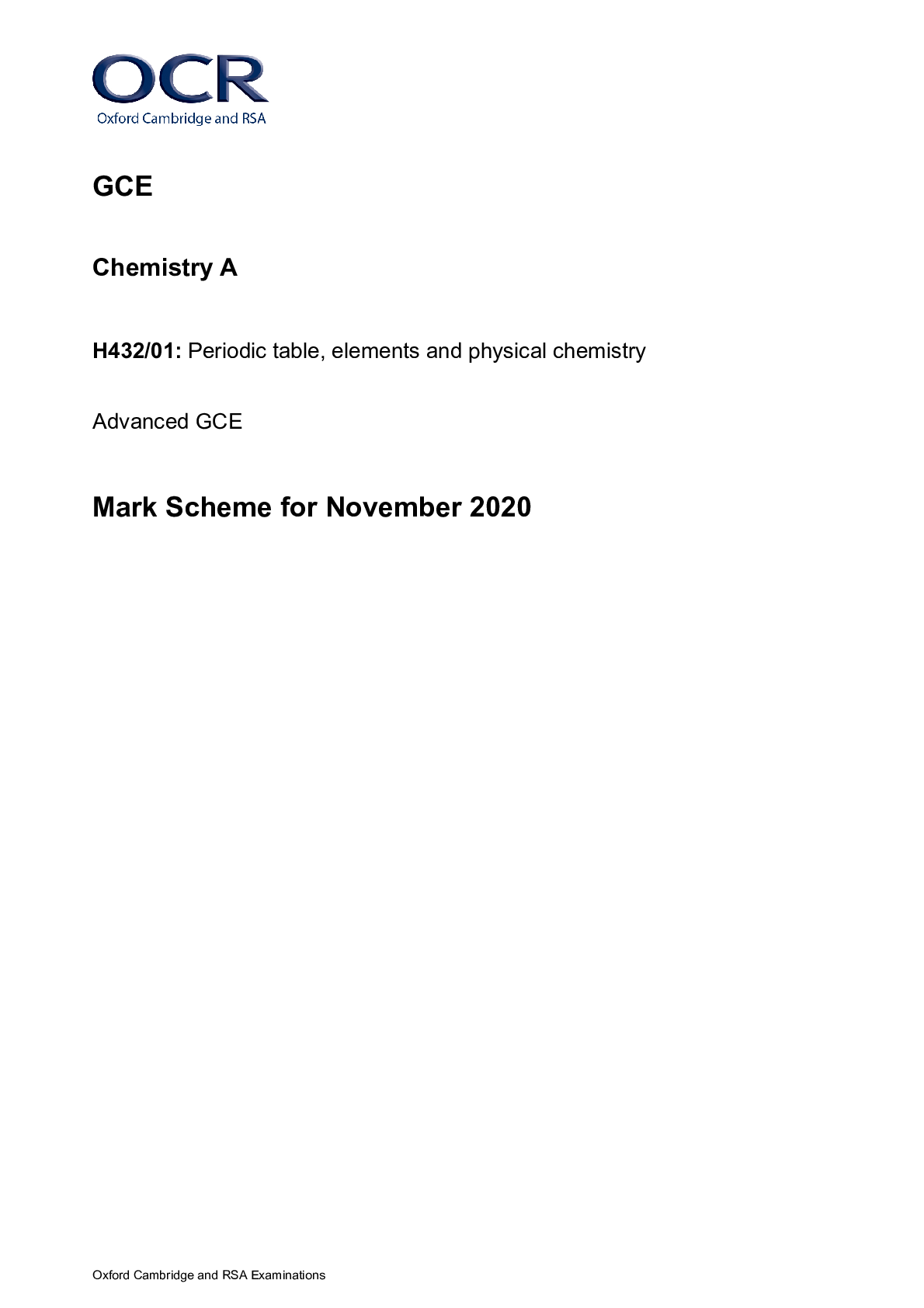


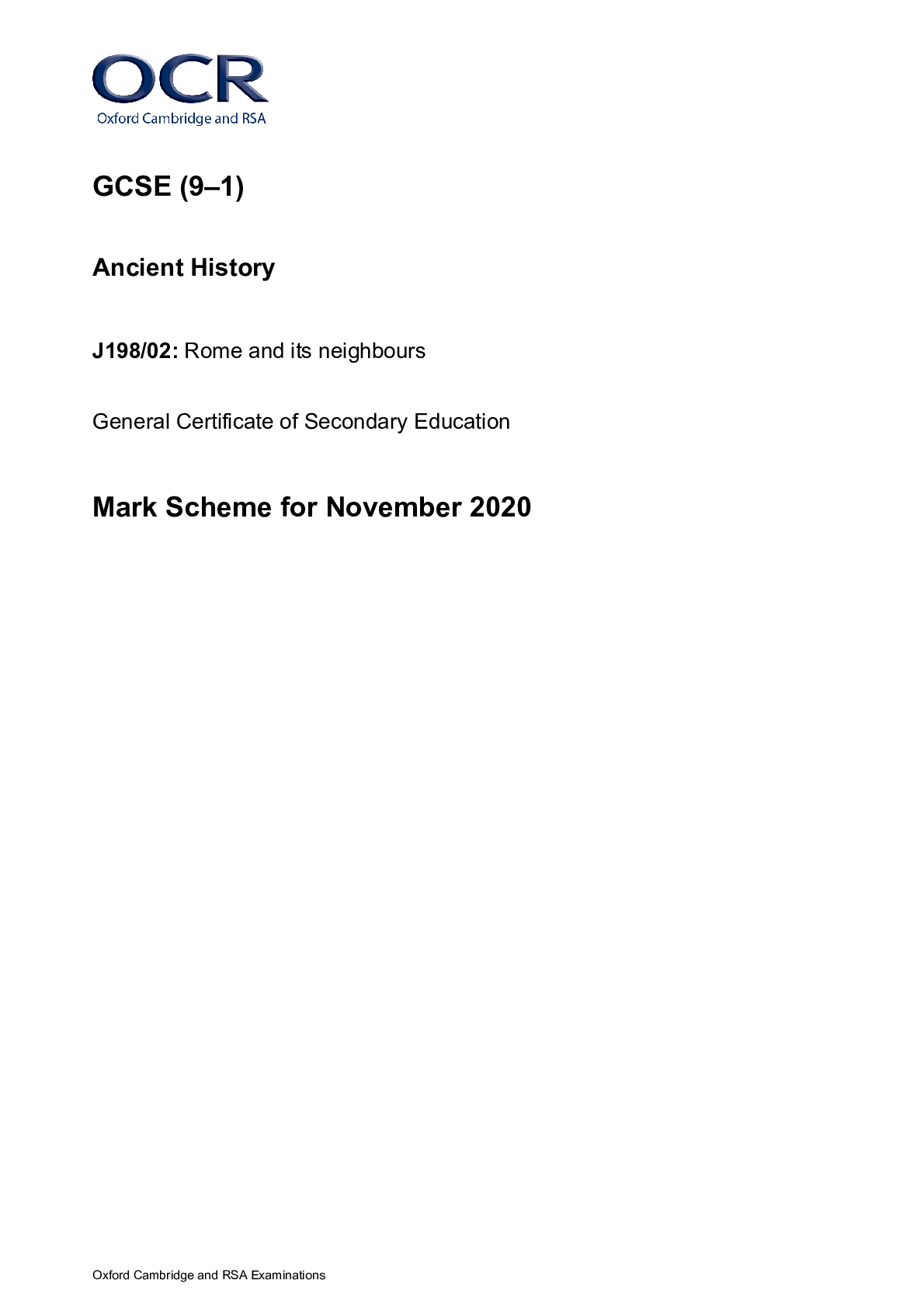




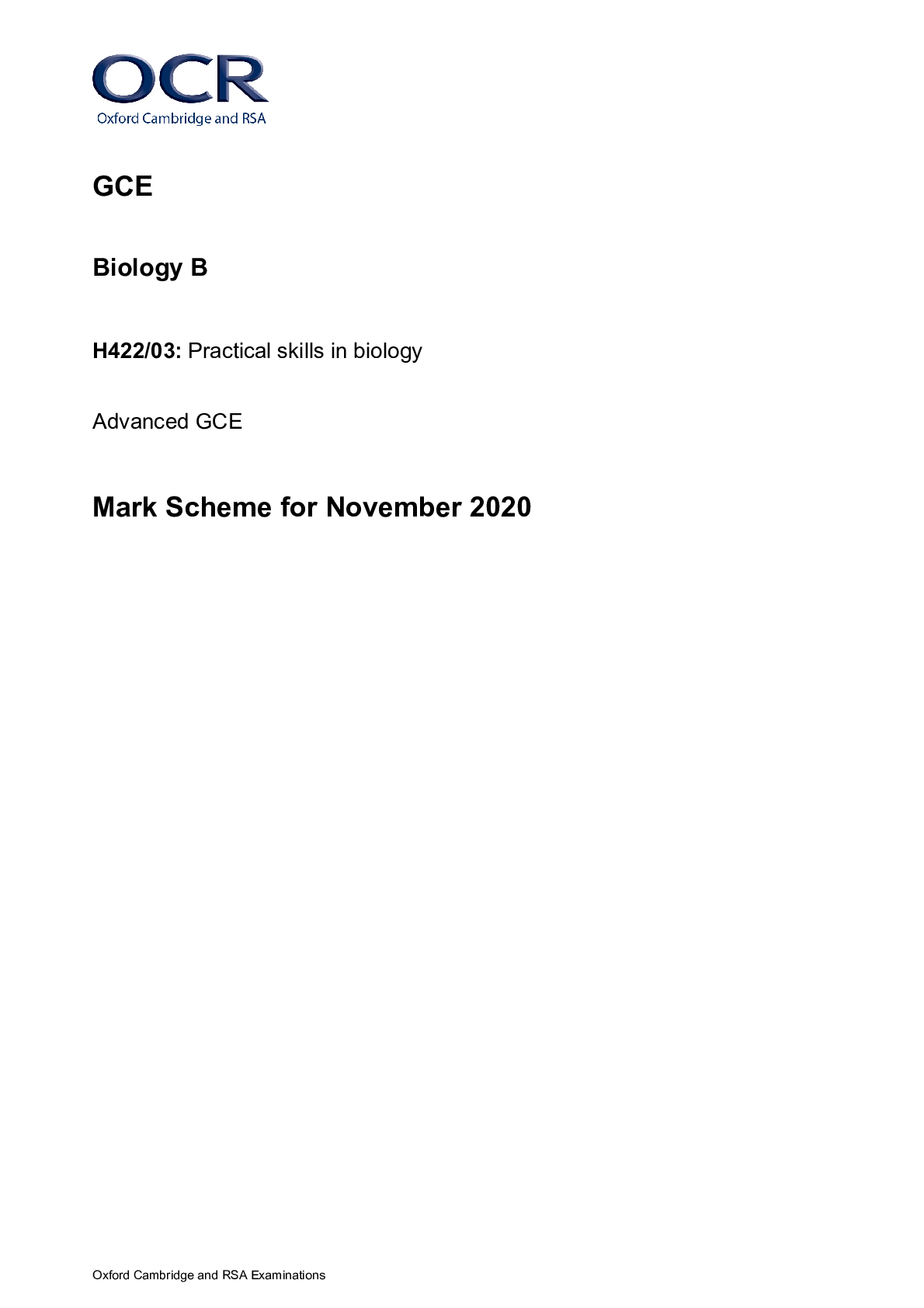
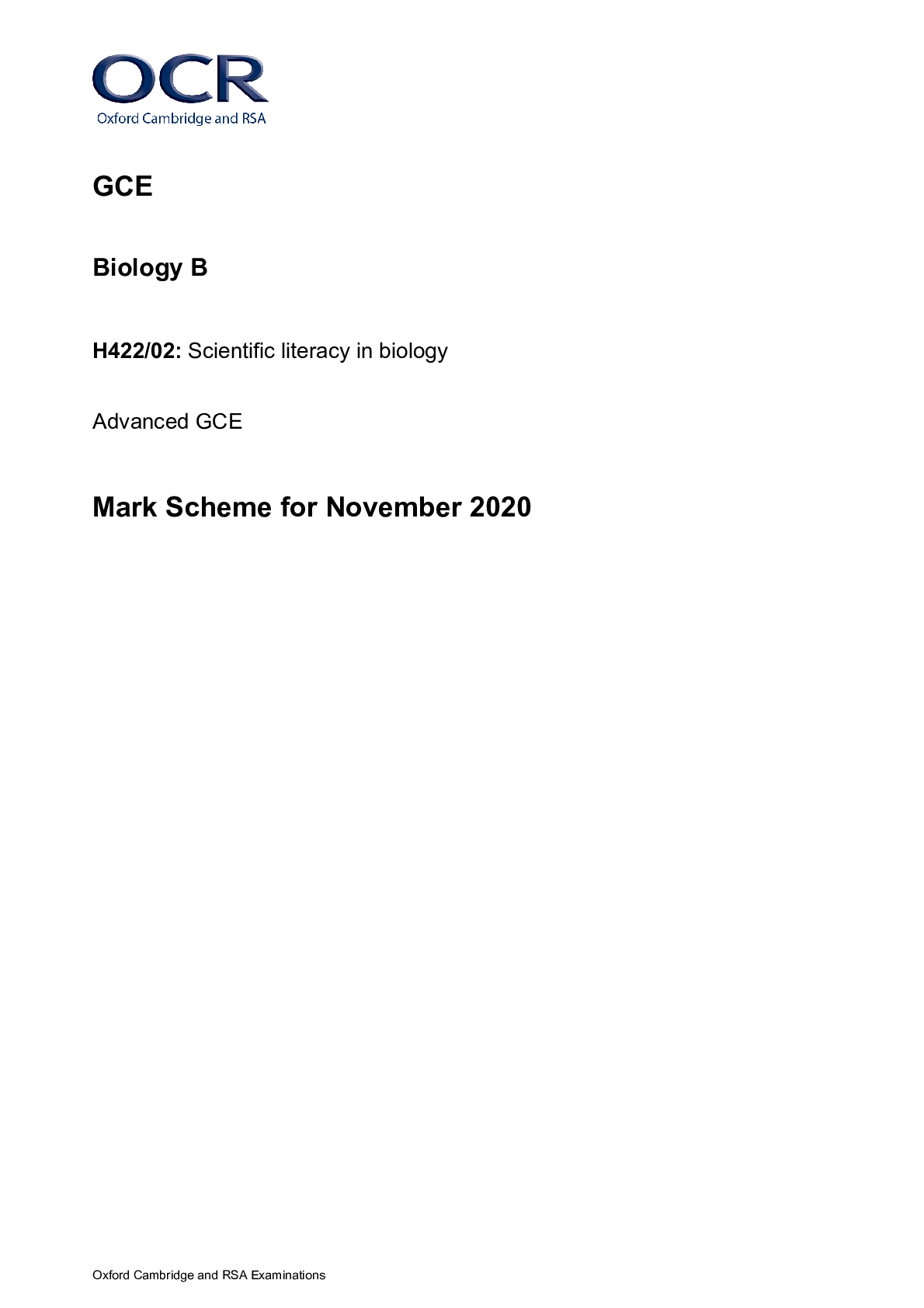
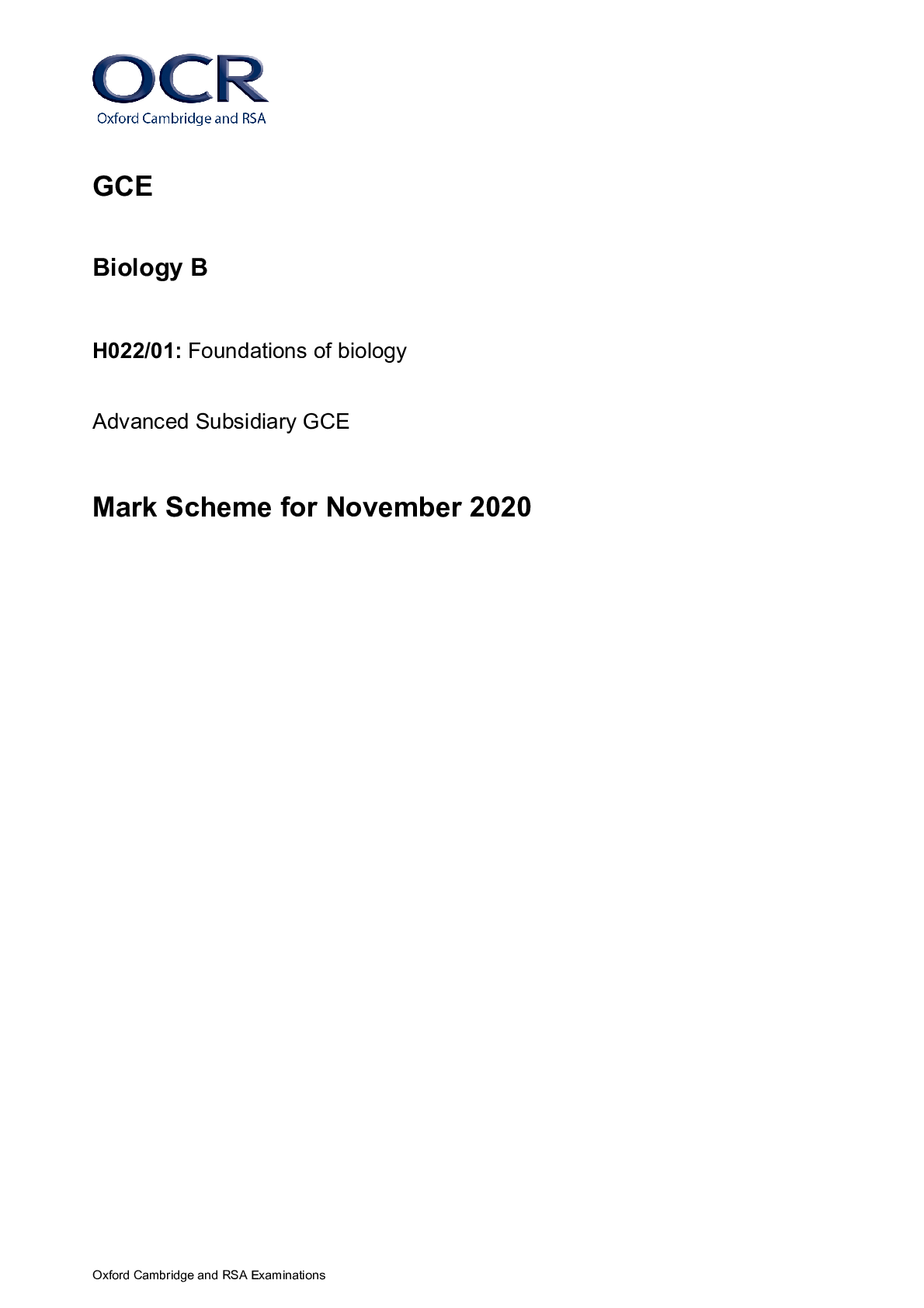



.png)



